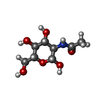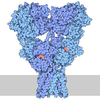登録情報 データベース : PDB / ID : 8jj1タイトル Cryo-EM structure of GluN1-2A NMDAR in complex with human Fab2G7 in two fab conformation (Glutamate receptor ionotropic, NMDA ...) x 2 Fab 2G7 Heavy Chain Fab 2G7 Light Chain キーワード / / 機能・相同性 分子機能 ドメイン・相同性 構成要素
/ / / / / / / / / / / / / / / / / / / / / / / / / / / / / / / / / / / / / / / / / / / / / / / / / / / / / / / / / / / / / / / / / / / / / / / / / / / / / / / / / / / / / / / / / / / / / / / / / / / / / / / / / / / / / / / / / / / / / / / / / 生物種 Homo sapiens (ヒト)手法 / / / 解像度 : 3.77 Å データ登録者 Wang, H. / Zhu, S. 資金援助 組織 認可番号 国 Other government 2022ZD0212700 Other government LG 202106-02 Other government 2017YFA0505700 Other government XDBS01020000 Other government 2018SHZDZX05
ジャーナル : Nat Struct Mol Biol / 年 : 2024タイトル : Structural basis for antibody-mediated NMDA receptor clustering and endocytosis in autoimmune encephalitis.著者 : Han Wang / Chun Xie / Bo Deng / Jinjun Ding / Na Li / Zengwei Kou / Mengmeng Jin / Jie He / Qinrui Wang / Han Wen / Jinbao Zhang / Qinming Zhou / Sheng Chen / Xiangjun Chen / Ti-Fei Yuan / Shujia Zhu / 要旨 : Antibodies against N-methyl-D-aspartate receptors (NMDARs) are most frequently detected in persons with autoimmune encephalitis (AE) and used as diagnostic biomarkers. Elucidating the structural ... Antibodies against N-methyl-D-aspartate receptors (NMDARs) are most frequently detected in persons with autoimmune encephalitis (AE) and used as diagnostic biomarkers. Elucidating the structural basis of monoclonal antibody (mAb) binding to NMDARs would facilitate the development of targeted therapy for AE. Here, we reconstructed nanodiscs containing green fluorescent protein-fused NMDARs to label and sort individual immune B cells from persons with AE and further cloned and identified mAbs against NMDARs. This allowed cryo-electron microscopy analysis of NMDAR-Fab complexes, revealing that autoantibodies bind to the R1 lobe of the N-terminal domain of the GluN1 subunit. Small-angle X-ray scattering studies demonstrated NMDAR-mAb stoichiometry of 2:1 or 1:2, structurally suitable for mAb-induced clustering and endocytosis of NMDARs. Importantly, these mAbs reduced the surface NMDARs and NMDAR-mediated currents, without tonically affecting NMDAR channel gating. These structural and functional findings imply that the design of neutralizing antibody binding to the R1 lobe of NMDARs represents a potential therapy for AE treatment. 履歴 登録 2023年5月29日 登録サイト / 処理サイト 改定 1.0 2024年6月5日 Provider / タイプ 改定 1.1 2024年9月11日 Group / Database references / カテゴリ / citation_author / em_adminItem _citation.country / _citation.journal_abbrev ... _citation.country / _citation.journal_abbrev / _citation.journal_id_CSD / _citation.journal_id_ISSN / _citation.pdbx_database_id_DOI / _citation.pdbx_database_id_PubMed / _citation.title / _citation.year / _em_admin.last_update 改定 1.2 2024年11月13日 Group / Structure summaryカテゴリ / pdbx_entry_details / pdbx_modification_featureItem / _pdbx_entry_details.has_protein_modification改定 1.3 2024年12月25日 Group / Database references / カテゴリ / citation_author / em_adminItem _citation.journal_volume / _citation.page_first ... _citation.journal_volume / _citation.page_first / _citation.page_last / _citation_author.identifier_ORCID / _em_admin.last_update
すべて表示 表示を減らす
 データを開く
データを開く 基本情報
基本情報 要素
要素 キーワード
キーワード 機能・相同性情報
機能・相同性情報 Homo sapiens (ヒト)
Homo sapiens (ヒト) データ登録者
データ登録者 中国, 5件
中国, 5件  引用
引用 ジャーナル: Nat Struct Mol Biol / 年: 2024
ジャーナル: Nat Struct Mol Biol / 年: 2024
 構造の表示
構造の表示 Molmil
Molmil Jmol/JSmol
Jmol/JSmol ダウンロードとリンク
ダウンロードとリンク ダウンロード
ダウンロード 8jj1.cif.gz
8jj1.cif.gz PDBx/mmCIF形式
PDBx/mmCIF形式 pdb8jj1.ent.gz
pdb8jj1.ent.gz PDB形式
PDB形式 8jj1.json.gz
8jj1.json.gz PDBx/mmJSON形式
PDBx/mmJSON形式 その他のダウンロード
その他のダウンロード 8jj1_validation.pdf.gz
8jj1_validation.pdf.gz wwPDB検証レポート
wwPDB検証レポート 8jj1_full_validation.pdf.gz
8jj1_full_validation.pdf.gz 8jj1_validation.xml.gz
8jj1_validation.xml.gz 8jj1_validation.cif.gz
8jj1_validation.cif.gz https://data.pdbj.org/pub/pdb/validation_reports/jj/8jj1
https://data.pdbj.org/pub/pdb/validation_reports/jj/8jj1 ftp://data.pdbj.org/pub/pdb/validation_reports/jj/8jj1
ftp://data.pdbj.org/pub/pdb/validation_reports/jj/8jj1 リンク
リンク 集合体
集合体
 要素
要素 Homo sapiens (ヒト) / 遺伝子: GRIN2A, NMDAR2A / 発現宿主:
Homo sapiens (ヒト) / 遺伝子: GRIN2A, NMDAR2A / 発現宿主:  Homo sapiens (ヒト) / 参照: UniProt: Q12879
Homo sapiens (ヒト) / 参照: UniProt: Q12879 Homo sapiens (ヒト) / 遺伝子: GRIN1, NMDAR1 / 発現宿主:
Homo sapiens (ヒト) / 遺伝子: GRIN1, NMDAR1 / 発現宿主:  Homo sapiens (ヒト) / 参照: UniProt: Q05586
Homo sapiens (ヒト) / 参照: UniProt: Q05586 Homo sapiens (ヒト) / 発現宿主:
Homo sapiens (ヒト) / 発現宿主:  Homo sapiens (ヒト)
Homo sapiens (ヒト) Homo sapiens (ヒト) / 発現宿主:
Homo sapiens (ヒト) / 発現宿主:  Homo sapiens (ヒト)
Homo sapiens (ヒト)
 試料調製
試料調製 Homo sapiens (ヒト)
Homo sapiens (ヒト) 電子顕微鏡撮影
電子顕微鏡撮影
 FIELD EMISSION GUN / 加速電圧: 300 kV / 照射モード: FLOOD BEAM
FIELD EMISSION GUN / 加速電圧: 300 kV / 照射モード: FLOOD BEAM 解析
解析 ムービー
ムービー コントローラー
コントローラー










 PDBj
PDBj















